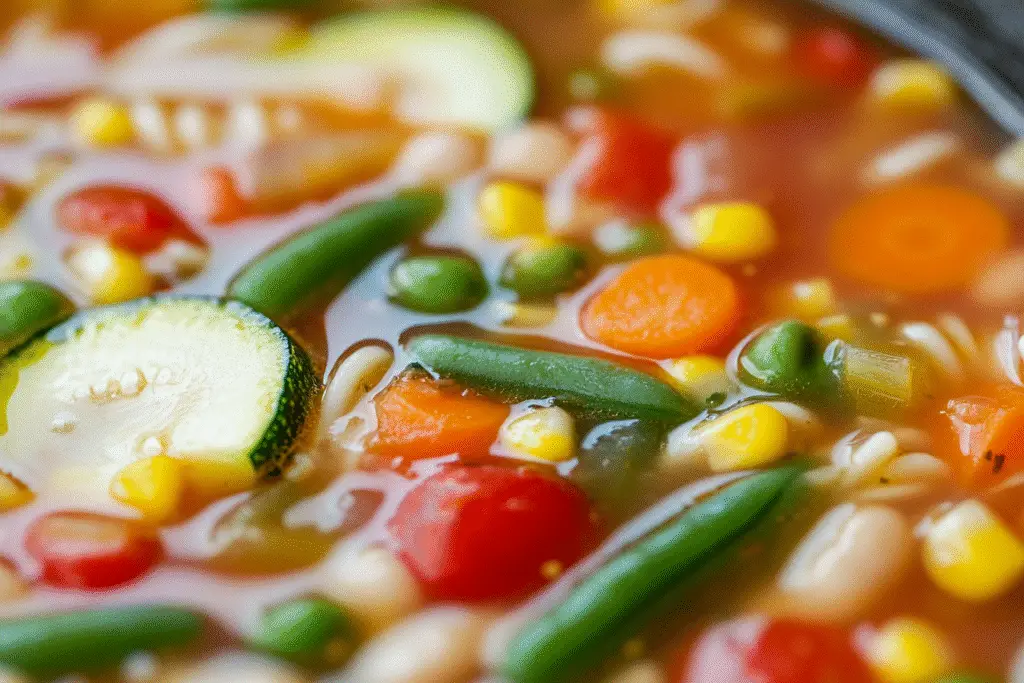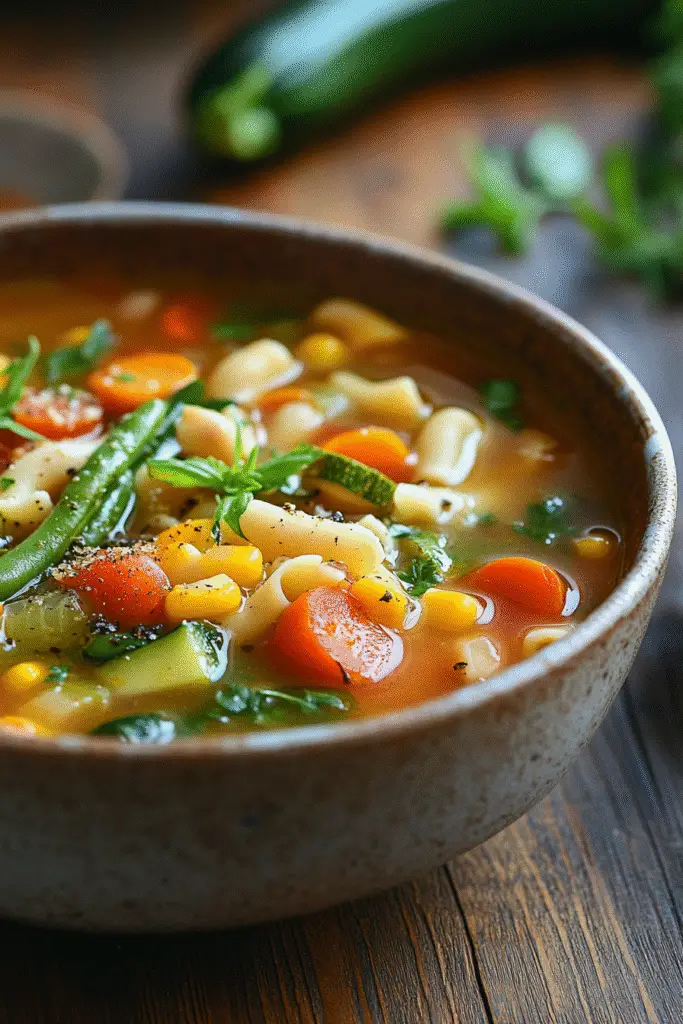A bowl of Hearty Summer Minestrone Soup is a vibrant celebration of the season, packed with an abundance of fresh vegetables, tender beans, and delicate pasta all simmered in a light, herb-infused broth. Unlike its heavier, winter counterpart, the summer version of minestrone is lighter, brighter, and built to showcase the best produce from warm-weather gardens and farmers markets.
This is not just a soup—it’s a satisfying, vegetable-forward meal that feels substantial without being heavy. Whether served warm, at room temperature, or even slightly chilled, this soup brings comfort, nourishment, and a beautiful harmony of flavors that scream summertime.
Why You’ll Love This Hearty Summer Minestrone Soup
Summer minestrone is endlessly adaptable and naturally satisfying. Unlike thick, stew-like winter soups, this version is brothier, faster to make, and packed with fresh textures. It’s the ideal one-pot meal for busy weeknights or leisurely weekend lunches.
Why this soup is a must-try:
- It’s light but filling thanks to beans and pasta.
- Perfect for meal prep—stores and reheats well.
- A great way to use up garden vegetables or market finds.
- Can be served hot, warm, or chilled.
- Easily customizable based on what’s in season.
This minestrone is about layering fresh flavors and keeping the vegetables tender but crisp—not overcooked—so each bite bursts with summery goodness.

Choosing the Best Ingredients for Summer Minestrone
The beauty of minestrone is its flexibility and seasonality. Here’s how to select the best ingredients for this warm-weather version.
Zucchini and Summer Squash
Choose small, firm zucchini or yellow squash with smooth, unblemished skin. Smaller squash are more tender and less watery.
Green Beans
Look for bright green beans that snap cleanly. Haricots verts (thin French beans) are a lovely option if available.
Sweet Corn
Fresh, sweet corn off the cob adds natural sweetness and texture. Use ears with green husks and golden silk.
Tomatoes
Ripe, juicy tomatoes (Roma, heirloom, or cherry) bring acidity and depth to the broth. Fresh tomatoes provide a brighter, fresher flavor than canned.
Leafy Greens
Spinach, Swiss chard, or kale can be stirred in at the end for color and added nutrients.
Beans
Cannellini beans, chickpeas, or kidney beans provide satisfying protein and heartiness without overpowering the delicate broth.
Pasta
Small pasta shapes like ditalini, orzo, or elbow macaroni are perfect for minestrone. Avoid larger pasta that can overwhelm the bowl.
Fresh Herbs
Basil, parsley, thyme, and oregano add brightness and are best stirred in just before serving.

Recommended Equipment for This Recipe
- Large stockpot or Dutch oven: Plenty of room for simmering all the vegetables and pasta.
- Sharp knife and cutting board: Essential for prepping a variety of vegetables.
- Ladle: For easy serving.
- Fine mesh strainer (optional): If you wish to clarify the broth.
- Grater: For Parmesan cheese, if using.
Common Challenges and How to Solve Them
1. Overcooked vegetables:
Add firmer vegetables like carrots and green beans first, and save delicate ones like zucchini, spinach, and corn for the final minutes to keep them tender-crisp.
2. Mushy pasta:
Cook the pasta separately and add just before serving if you plan to store leftovers. Pasta left in the broth will continue to absorb liquid and soften.
3. Bland broth:
Use a high-quality vegetable broth and season generously. Adding a Parmesan rind while simmering deepens the flavor. Finish with fresh herbs, lemon juice, or a drizzle of good olive oil to brighten the final dish.
4. Soup too thick after storage:
The pasta and beans will absorb broth as the soup sits. Simply add extra broth or water when reheating to restore the consistency.
Flavor Enhancements and Creative Additions
- Pesto drizzle: A spoonful of basil pesto on top adds a bright, herbaceous punch.
- Parmesan rind: Simmer with the broth for subtle, savory depth.
- Chili flakes: For a hint of heat.
- Fresh lemon zest or juice: Enhances brightness and balances sweetness.
- Roasted red peppers: Add sweetness and complexity.
Smart Preparation Strategies
- Make ahead: This soup stores well, but to keep pasta al dente, consider cooking it separately and adding just before serving.
- Double the batch: Perfect for feeding a crowd or freezing for later.
- Use leftovers creatively: Excellent for transforming extra vegetables into a completely new meal.
Substitution Guide for Dietary Needs
- Vegan: Use vegetable broth and skip Parmesan or replace with vegan Parmesan.
- Gluten-free: Swap pasta for gluten-free noodles or cooked rice.
- Low-carb: Omit pasta and beans and bulk up with more vegetables.
- Protein boost: Add cooked shredded chicken or white beans for extra protein.
Ingredients
For the Soup
- 2 tablespoons olive oil
- 1 medium yellow onion, diced
- 3 garlic cloves, minced
- 2 medium carrots, diced
- 1 zucchini, sliced into half-moons
- 1 cup green beans, trimmed and halved
- 1 ear sweet corn, kernels removed (or 1 cup frozen corn)
- 3 ripe tomatoes, chopped (or 1 cup cherry tomatoes, halved)
- 1 can (15 oz) cannellini beans, rinsed and drained
- ¾ cup small pasta (ditalini, orzo, or elbow macaroni)
- 6 cups vegetable broth
- 1 teaspoon salt, plus more to taste
- ½ teaspoon freshly ground black pepper
- 2 cups fresh spinach or Swiss chard
- ¼ cup fresh basil leaves, chopped
- Optional: Parmesan rind for simmering
Optional Garnishes
- Fresh basil leaves
- Grated Parmesan cheese
- Drizzle of olive oil
- Spoonful of pesto
- Lemon wedges
Instructions
Step 1: Sauté the Aromatics
In a large stockpot, heat the olive oil over medium heat. Add the diced onion and carrots and cook for 5-6 minutes until softened. Stir in the minced garlic and cook for another 30 seconds until fragrant.
Step 2: Build the Broth
Pour in the vegetable broth and bring to a gentle simmer. Add the salt, pepper, and Parmesan rind (if using).
Step 3: Add Hearty Vegetables
Add the green beans and corn to the simmering broth and cook for 5-7 minutes until beginning to soften.
Step 4: Stir in Zucchini, Tomatoes, and Beans
Add the zucchini, tomatoes, and cannellini beans. Simmer for another 5 minutes until the zucchini is tender but still crisp.
Step 5: Cook the Pasta
Stir in the small pasta and cook for 6-8 minutes, or until al dente. Stir occasionally to prevent sticking.
Step 6: Finish with Greens and Herbs
Add the spinach and cook for 1-2 minutes until wilted. Remove the Parmesan rind, if used. Stir in the fresh basil and taste the soup, adjusting seasoning with more salt, pepper, or lemon juice as needed.
Step 7: Serve
Ladle the soup into bowls and garnish with additional basil, a drizzle of olive oil, grated Parmesan, or a spoonful of pesto if desired.
Serving Suggestions
- Serve with crusty bread or focaccia to soak up the broth.
- Pair with a simple tomato and mozzarella salad.
- Enjoy as a light standalone meal or a hearty starter.
Troubleshooting
- Vegetables overcooked: Next time, stagger the vegetable additions more carefully.
- Soup thickened after chilling: Thin with additional broth or water when reheating.
- Flavor seems flat: Finish with lemon juice, pesto, or fresh herbs to brighten.
Storage and Reheating
- Refrigeration: Store in airtight containers for up to 4 days. Pasta may soften over time.
- Freezing: Best if frozen without pasta. Freeze for up to 2 months. Add fresh-cooked pasta when reheating.
- Reheating: Gently reheat on the stovetop, adding broth if needed to loosen the soup.
Variations: Summer Minestrone vs. Winter Minestrone vs. Gazpacho
- Summer Minestrone: Brothy, light, packed with fresh, tender vegetables. Often served warm or room temperature. Less tomato-heavy.
- Winter Minestrone: Thicker, heartier, often includes potatoes, cabbage, and a more robust tomato base.
- Gazpacho: A cold, blended soup made with raw vegetables. Completely different in texture and style from minestrone.
This Hearty Summer Minestrone Soup is a perfect example of how satisfying and beautiful simple, seasonal cooking can be. It’s a vibrant, feel-good dish that celebrates everything summer has to offer—color, freshness, and uncomplicated joy.
